Kwarkot/iStock via Getty Images
July CPI, Inflation, and the Jobs Report
Barring this week’s CPI results which the markets perceived as good news that led to a rally with the Nasdaq +20% from recent lows and the S&P 500 reaching the highest level in three months, the markets have been on a volatile swing. Where bad news for the economy was good for the markets, potentially leading the Fed to ease monetary policy, good news for the economy appeared bad as it could prompt the Fed to increase rates.
Weeks of bear market bounce have seen little signs of cracking. Following the latest jobs report, investors were concerned about potential headwinds that ‘sizzling’ employment and labor strength would be an indication that the Fed would increase rates, or at the very least, proceed with a 75-basis point hike. And although the initial news of a strong labor market resulted in mixed results because investors still fear recession and a potential hawkish Fed, July’s CPI of 8.5%, a decline from June’s 9.1%, may be the turning point that good news is good news.
U.S. CPI Chart – Cooling Inflation (Bloomberg – Bureau of Labor Statistics)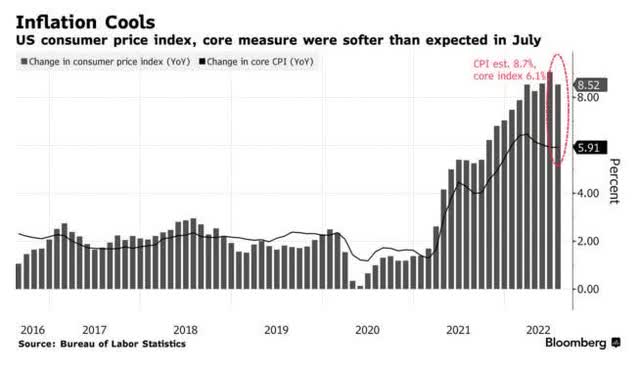
As CPI measured softer than expected in July, inflation appears to be cooling, prompting stocks to soar yesterday. Inflation came in below expectations, which indicates to the market that the Fed may not have to continue raising rates aggressively. While they want to see more consistent downward pressure in core CPI, what’s interesting is that most of the decrease resulted from a fall in energy – fuel, and gas.
Whereas food and shelter costs experienced the biggest increases, these sticky costs may take a while to come down. Food increases have been the most sensitive, +10.9% from last year, the largest increase since 1979. Because these categories tend to be essential and therefore prices are difficult to control, recession fears remain, as the Fed may need to raise rates to temper rising costs. With this precaution in mind, the latest CPI report could spell big news for some stocks, especially those beaten-down throughout the year. Stocks like (UPST), (SPOT), (NASDAQ:ROKU), (SHOP), (DOCU), and (NYSE:CVNA) that our Quant Ratings & Factor Grades have warned investors to avoid or sell long before their earnings misses, may be rallying on irrational exuberance following Wednesday’s CPI. Some investors are jumping headfirst into the action, not considering the potential consequences of stocks whose characteristics have historically been associated with poor future performance. While some growth stocks may benefit from the ‘good news,’ it’s vital to take into account their underlying metrics.
Are Growth Stocks Back in Action?
Irrational exuberance may be prompting the latest market rally. Quality is key to selecting stocks, especially following positive news, which is why I emphasize fundamentals and focus on key characteristics like valuation, growth, momentum, profitability, and EPS revisions before selecting stocks for a portfolio. Although the latest CPI results were received as good news, the Fed has said they need to see more than one month of cooling before they make a final decision.
While CPI came in lower than expected, inflation is still high; food costs are high; housing costs keep climbing, which could result in the Fed raising rates. The jury is still out on that. And because many growth stocks are sensitive to interest rates, it’s important to dig into what makes them attractive for investment.
When you discount future earnings with higher interest rates, it produces lower growth and less profitability from an expectation perspective. The notion that interest rates won’t be as high as the Fed indicated bodes well for lower-quality stocks that now, when you discount future earnings, can use a lower discount rate. Take Carvana Co. (CVNA), for example.
Carvana (CVNA) Rallies following July CPI Report
Carvana (CVNA) Stock Rallies following July CPI Report (Seeking Alpha Premium)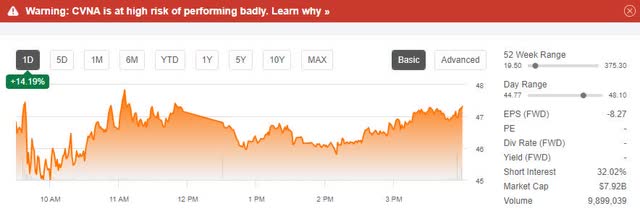
The stock rallied +14.19% on the news of July CPI, despite CVNA’s one-year share price decline of 87.22%. JPMorgan downgraded the stock following its recent 2022 Q2 Earnings miss that resulted in 16 analysts’ downward revisions over 90 days. Just because CPI is better-than-anticipated does not mean the Fed will be dovish. A one-day rally may be the result of investors betting on a best worst-case scenario. Better CPI does not mean that valuations and earnings won’t be hit as hard as anticipated. This rally and positive sentiment on the heels of the report may be leading to false rationale of stocks at risk of performing badly, according to quant ratings; a result of irrational exuberance; companies like Carvana are still unprofitable.
Roku, Inc.
Roku, Inc. is another example. Take a look at its poor investment characteristics below.
ROKU’s Poor Report Card & Ratings on Key Investment Characteristics
Roku Stock Poor Report Card & Ratings on Key Investment Characteristics (Seeking Alpha Premium)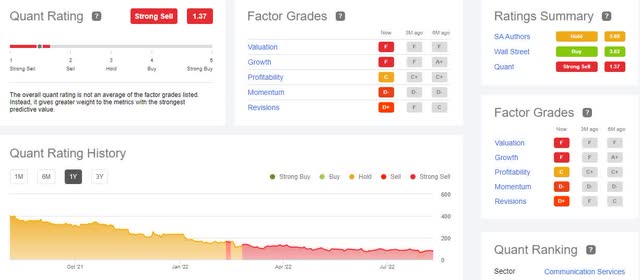
Not only is this stock at a high risk of performing poorly, but the stock also experienced a +3.82% boost to close the market, following CPI results, making positive pre-market moves to start the next day. Will improvement in market sentiment pose beneficial for stocks like UPST, SPOT, ROKU, SHOP, DOCU, and CVNA? Only time will tell. Seeking Alpha’s Quant Grading System is an excellent resource that provides warnings when a stock is at risk of performing badly to allow investors to focus on quality stocks to grow their investment portfolio. Avoid the stock losers. Assess stocks based upon key characteristics.
Stock Valuation, EPS Revisions, and Momentum
As I recently wrote in Heed the Warnings: Earnings In the Red Could Mean Your Stock is Dead Money,
“Seeking Alpha’s quantitative system aims to focus on the best characteristics of the fundamental building blocks of stocks. We like to base the quant investment strategy on highlighting companies with solid growth potential at a reasonable price, also known as Growth at a Reasonable Price (GARP). GARP measures the quality and health of stocks using our grading system. It also showcases those stocks with less-than-optimal characteristics. Let’s dive into the first building block, valuation.”
Stock Valuation
Investors want to know a stock’s worth and whether it is priced at a premium or discounted. Using Upstart Holdings, Inc. (UPST) as the valuation, momentum, and revisions grade example, this cloud-based artificial intelligence (AI) lending platform is extremely unattractive on each of these characteristics, landing an overall F grade. Not only is UPST considered highly overpriced compared to its sector peers given its trailing P/E ratio of 35.20x is 221.15% higher than the sector, its forward Price/Book of 4.15x is also a 246.59% difference to the sector.
Upstart Stock Valuation (Seeking Alpha Premium)
Meanwhile, the Financials sector median is at 10.96x and 1.20x, respectively. And with its latest 2022 Q2 earnings miss that produced an EPS of $0.01 that missed by $0.07 and revenue of $228.16M that missed by nearly 18% year-over-year, eight analysts gave downward revisions in the last 90 days. There are many factors that may have contributed to the stock’s disappointing revisions. The key is diving to uncover the reasons and how they play into the momentum and outlook of the company.
Upstart (UPST) Stock Momentum (Seeking Alpha Premium)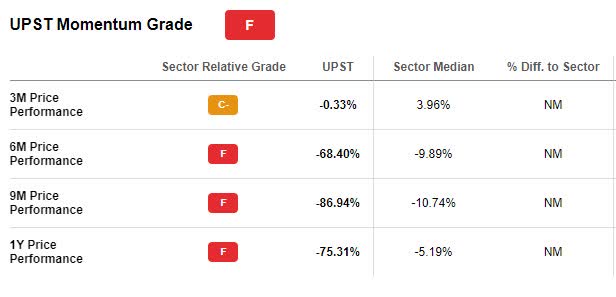
Despite market speculators cheering this stock following July’s softer-than-expected inflation data, prompting Upstart’s bullish upswing, along with several other stocks, when assessing UPST’s quarterly momentum and YTD share price decline of 76.84%, investors may want to proceed with caution. We consider the Momentum Factor Grade one of the most important of our five core factors concerning price predictability, which is why Upstart’s risk warning and its momentum grades are well warranted. All of the stocks mentioned here, UPST, SPOT, ROKU, SHOP, DOCU, and CVNA have been bearish and displayed weak guidance. Before jumping into bearish ideas as a result of softer-than-expected inflation data, consider the overall picture and that the good news may have prompted a brief stint of irrational exuberance.
Conclusion
Less aggressive interest rates appeal to the markets and inventors. Whether or not the Fed will be hawkish or dovish for the September 21st gathering remains to be seen. Before taking action for fear of missing out (FOMO), consider evaluating your stock pick(s) by creating a Seeking Alpha portfolio, a tool that will help determine the losers in a portfolio that can save you from catastrophic losses.
SA Quant Sell Recommendations vs S&P 500 (Seeking Alpha Premium)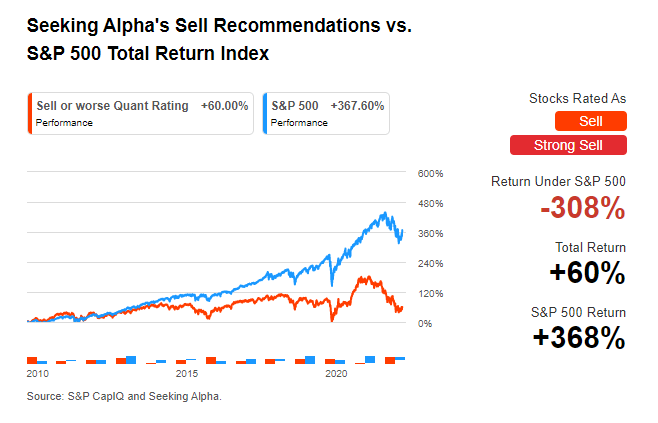
If you had some of the stocks mentioned in this article, UPST, SPOT, ROKU, SHOP, DOCU, and CVNA, you would have received a warning banner, or at the very least noted the poor factor grades and characteristics. Seeking Alpha’s sell recommendations are a powerful way to help avoid catastrophic losses. The good news of moderating inflation may appear to be an opportunity to buy at a lower price. But these growth stocks come with risks with extreme risks. Like we’ve seen with the bearish bounce this year, good news can be bad for stocks, while bad news may be good. The latest CPI results may be good news this go-around, but we implore you to consider the Quant System that can readily identify stocks at risk, as well as those with Strong Buy recommendations.


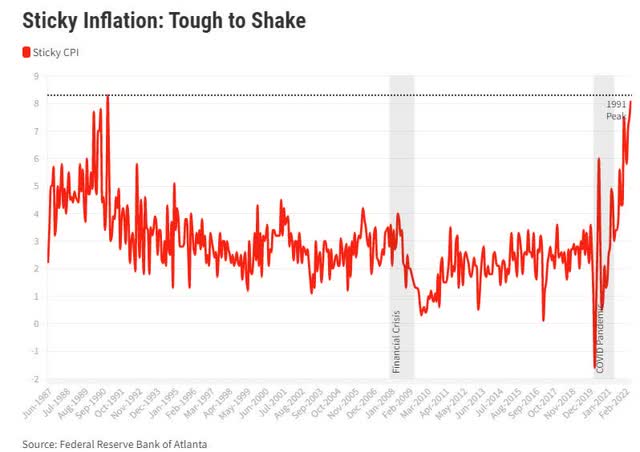
Be the first to comment